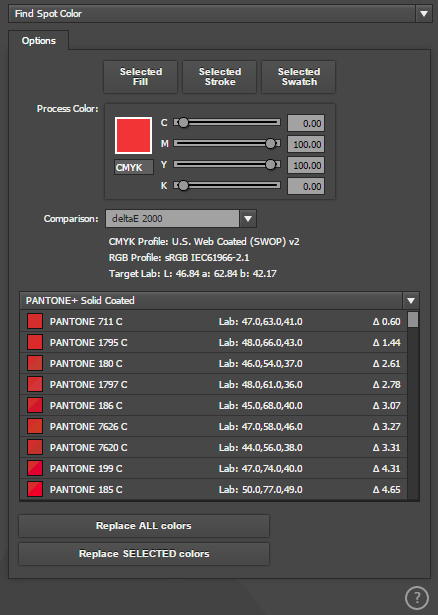Table of Contents
Find Closest Spot Color PowerScript for Adobe Illustrator
Given an CMYK, RGB or Lab color this Powerscript will find the closest spot color from a color book.
Interface
About Delta E
The Delta E is the difference or distance between two colors. The lower the number the closer the match. Delta E values of less than 1 are considered exact matches, with values less than 23- being a just noticeable difference.
However while the lowest number may be the closest color match is may not be the best match for your print job. For example the standard CMYK red of 100% Yellow and 100% Magenta is closest match to Pantone 711C, however because CMYK gamut is smaller than that of Pantone colors you may want to choose a more common red like PMC 186C which is a strong more vibrant red.
This PowerScript will tell you the closest color but use your best judgement when choosing the spot color.
There are 4 different standard formulas you can choose from
deltaE 1976
The 1976 formula is the first color-difference formula that related a measured to a known set of CIELAB coordinates. This formula has been succeeded by the 1994 and 2000 formulas because the CIELAB space turned out to be not as perceptually uniform as intended, especially in the saturated regions. This means that this formula rates these colors too highly as opposed to other colors.
deltaE 1994
The 1976 definition was extended to address perceptual non-uniformities, while retaining the L*a*b* color space, by the introduction of application-specific weights derived from an automotive paint test's tolerance data
deltaE 2000 (Recommended)
Since the 1994 definition did not adequately resolve the perceptual uniformity issue, the CIE refined their definition, adding five corrections. Including hue rotation and compensation for neutral colors, lightness, chroma and hue
deltaE CMC
In 1984, the Colour Measurement Committee of the Society of Dyers and Colourists defined a difference measure, also based on the L*C*h color model. Named after the developing committee, their metric is called CMC
